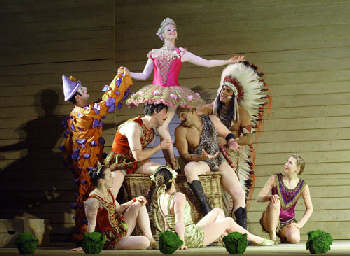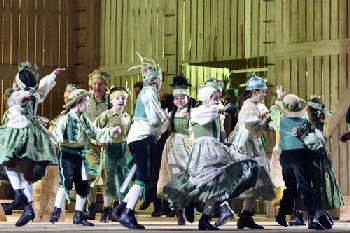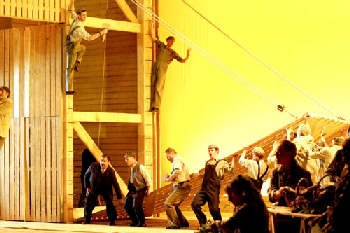
This was only my second performance of The Bartered
Bride, the last one about 20 years ago at the London
Coliseum and here it was in English again but at Covent
Garden this time. Kit Hesketh-Harvey justifies his anachronistic
translation with a number of points including the fact
that it is easier for non-Czech speaking singers – naturally
– and also that it can ‘help the comedy’. That is the
problem because, in fact, there were precious few laughs
in the first two acts despite the production team sitting
near me ‘splitting their sides’ at every supposedly
funny moment.
This
is the second of eight operas written by Bedřich
Smetana. The Czech libretto was by Karel Sabina who was
also responsible for his first work, The Brandenburgers
in Bohemia. Smetana himself conducted the first performance
and its first outings were not a success. There are four
versions with the original 1866 version being in two acts;
by the third performance the composer had already begun
to tinker with his opera which resulted in the first revision
of 1869, the second that same year was now in three acts
and the first performance of a so-called definitive version
(now with new recitatives instead of spoken dialogue)
was at the Provisional Theatre in Prague on 25 September
1870. It has become the only one of Smetana’s operas to
gain a popular place in the repertory outside its homeland
(though I suspect it is less ‘popular’ now than it once
was). Smetana of course, preferred his later opera, Dalibor,
and was very dismissive of Bartered Bride.

The characterizations are poor apart from the more
rounded figures of Kecal, the marriage-broker, and Mařenka,
the heroine. Vašek, for instance, is an odd one-dimensional
soul with dimmed wits. Despite an article in the programme
making excuses for him because of a domineering mother
there is rather a lot of non-PC sneering at the poor stuttering
simpleton in a green suit and big bow that his ‘Mamma’
had no doubt bought him. Making fun of the mentally challenged
is an old theatrical device and is more sympathetically
handled in L’Elisir d’amore and in the ballet La
Fille mal Gardée. Bartered Bride shares a lot
of the same bucolic character as Donizetti’s opera of
some 30 years previous to Smetana’s composition and it
remains by far the better of the two works.
In fact Bartered Bride is a bit of a creaky
old piece and despite the support of the conductor Sir
Charles Mackerras, part of whose eightieth birthday celebrations
these performances are, is in need of a touch of the ‘authentic’
that seems so strangely important for some operas but
not others. Conflating the first two acts into one possibly
based on Smetana’s earliest ideas seems overdue. And if
Bartered Bride is worthy of being staged then why
not Wagner’s Das Liebesverbot and the Weber/Mahler
Die drei Pintos, neither far removed from it in
sound or spirit?

Set in a huge wooden barn so pristine I looked for
sponsorship from Ikea, Kecal is hired to broker the marriage
between Mařenka and Vašek, the son of Micha a wealthy
landowner. Kecal is made aware of the relationship between
Mařenka and Jeník and becomes determined to break
them up. He works on Jeník who eventually ‘barters’ his
bride away for 10,000 crowns much to the villagers’ consternation.
There is often lots of folkloric jollity and prancing
about but together it is ‘too long by half’. Unfortunately
the very committed Royal Opera House chorus had no real
energy or technique as dancers, however well they sang,
and failed to bring the village scenes to much life.
Act III seems to be from an entirely different work
with the arrival of the travelling circus. There are now
two ‘turns’ of excellent comic timing to cheer everyone
up in Robert Tear’s Ringmaster (his ‘sod it!’ on hearing
of his ‘bear’s’ indisposition was memorable) and Eddie
Wade’s Indian. There is a long and emotional, almost Verdian,
solo for Mařenka that was a late addition by Smetana
to his score. Here she vows never to marry, before a delightful
quintet from both sets of parents and Kecal convinces
her to marry Vašek because of Jeník’s seeming betrayal
of their love. As the opera spirals to its inevitable
happy ending, Mařenka has already tried to trick
Vašek who becomes enamoured by the tightrope-walker Esmeralda
(a perky Yvette Bonner). Jeník is revealed as the long-lost
son of Micha. The terms of the contract with Kecal whereby
Jeník gave Mařenka up allows her to marry either
son and, of course, she chooses Jeník. A frightened child
rushes in to exclaim a bear has escaped from the circus.
In comes the ‘bear’ which pulls off its head revealing
Vašek who announces he has joined the circus. As the happy
couple are blessed the curtain falls.
The children through their innocence and joy of
performance are a highlight of director Franceska Zambello’s
staging. It was first put on in 1998 and is really more
of a ‘show’ with just a hint of the choreography of Mary
Poppins or The Lion King at times. The children
had all the energy some of the adults appeared to lack.
Simon O’Neill making his Covent Garden début as
Jeník is quite a Heldentenor discovery; among other awards
he is a previous winner of a UK Wagner Society Prize (not
always a sign of quality - and as their former chairman
I should know!). He is definitely a future Walther and
Siegfried. Unfortunately like many of his breed his acting
was as wooden as the scenery. Mařenka was Susan Gritton
who seemed as feisty as Katherine Hepburn when she first
appeared; her character really never softened very much
and she remained one of Smetana’s typically strong and
assertive women. Both Ms Gritton and Timothy Robinson
(Vašek) have appeared previously in this production; he
did his best in this role that shows so little development
to involve the audience in his predicament. Yvette Bonner,
Robert Tear and Donald Maxwell (Krušina, Mařenka’s
father) had also already appeared before, the latter two
making up in presence for what they now lack in voice.
The bass Peter Rose was suitably conniving as Kecal,
without entirely giving in to the broad acting this part
would benefit from. What was good was how his lowest notes
were reflected in the translation by repeated mentions
of ‘base’. (By the way, when the translation had it sung
at the end that Vašek did not have the ‘nature’ to be
a husband I think we probably all knew what Kit Hesketh-Harvey
is suggesting!)
Even I found myself, after enduring the first two
acts, battered into submission and caught up in the colour,
gaiety and occasional greater depth of feeling in Act
III. (Much of the same experience I felt during the new
film version of King Kong where a similar rather
simple entertainment is spoilt by excessive length. In
both these cases a judicious use of a pair of scissors
would have been appropriate.) The opera was undoubtedly
chosen for Charles Mackerras and his milestone birthday,
and it obviously benefited from his immense knowledge
and love for the music. He enthusiastically conducted
an orchestra who were on top form themselves. He is one
of the last surviving musical giants of his generation
having begun conducting with Sadler’s Wells Opera nearly
60 years ago. Happy Birthday Sir Charles!
© Jim Pritchard
Photographs © Royal Opera House Covent
Garden, photographer Catherine Ashmore.





